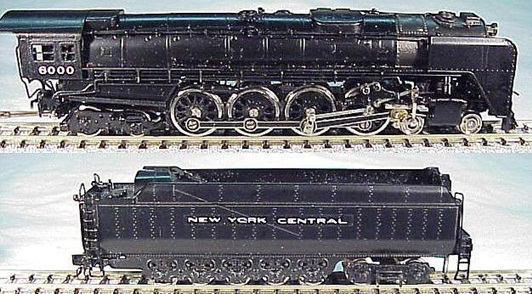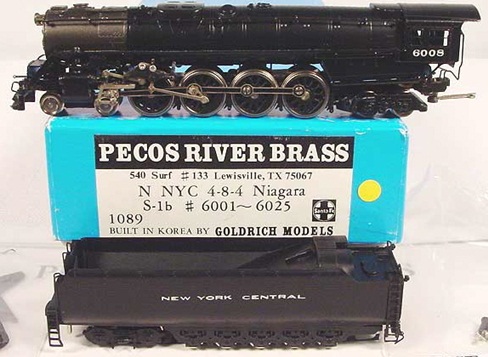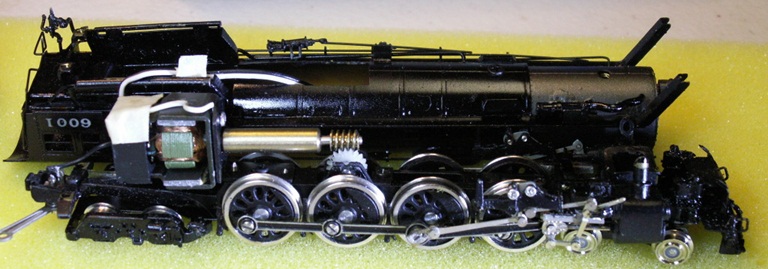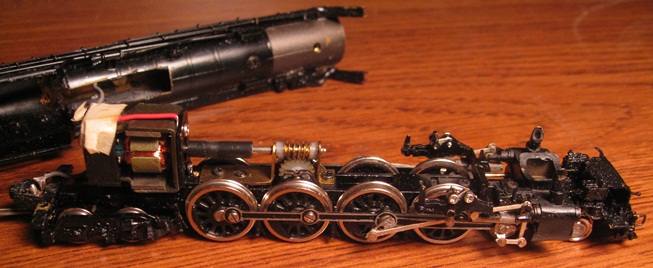| S-1a | S-1b |
 |  |
| S-1a | S-1b |
 |  |
Introduced: 1991
These models came out at the same time and, apart from some minor prototypical differences, look to be virtually identical.
The engine chassis is metal and fairly minimalistic (with most of the actual heft provided by the brass shell). The motor is an open-sided, straight-wound five-poler. Right-rail pickup is provided by three of the four right-side drivers (the second pair of drivers from the front being equipped with traction tires). Left-rail pickup is provided by all of the left-side tender wheels (with current transferred from the tender to the engine by way of a stiff metal wire on the drawbar). All the rest of the wheels are electrically neutral. Only one pair of drivers is geared (the third pair from the front). The worm turns a plastic idler gear, which then turns a brass axle gear. A non-directional headlight is mounted inside the boiler (the wiring for which comes with a two-pin plug, allowing one to disconnect the boiler from the chassis). The pilot is equipped with a non-operational knuckle coupler. There is no coupler on the tender, although space is provided for installing a Micro-Trains coupler on the tender chassis. Wheels are low-profile, so no problems on Code-55 rails.

Smoke deflectors (aka elephant ears) are supplied ala carte. And according to a poorly worded box insert, they can supposedly be installed and removed as needed. But frankly, I'm just not seeing it. The clips on the ears that are supposed to hold them to the stairs are very loose fitting, with the net result being ears that simply won't stay put. If I wanted to run mine with ears I would definitely use glue to hold them in place. For reasons I can't quite explain, the S-1a comes with a coal load for the tender, whereas the S-1b does not.
The 2-axle truck on the tender is sprung, although this seems to cause more problems than it solves. Mine was forever derailing until I simply got rid of said spring. Once removed, I no longer had any problems. The pilot truck is not encumbered with a spring, and wow, is it ever floppy. Still, it does seem more or less content to stay on the rails. This locomotive seems to be able to handle curves as sharp as 11"-radius, but that's really pushing it. I'd say that 19"-radius is a more realistic minimum.
As pictured above, the original release included a one-piece brass driveshaft/worm assembly. Said assembly was not secured to the chassis in any way, and the net result was a lot of noise and vibration. In fact, some owners even reported problems with stalling; caused by the worm losing contact with the worm gear entirely. In response to customer complaints, Pecos River released a "fix kit" that included a redesigned driveshaft/worm and a couple of brass strips for bracketing the worm in place. This new driveshaft scheme eliminated the stalling problems, and made for much smoother and quieter running overall.

Unfortunately, even with the redesigned driveshaft performance is still fairly mediocre. The motor does not have sufficient torque for an engine of this size, making for poor running at slow speeds. And the stiff wire on the drawbar is simply not a reliable way to move current around. No, out and out stalls are not a problem. Rather, it just tends to run a bit jittery (with the headlight constantly flickering as the tender current comes and goes). So, a nice looking model, but ultimately a bit of a shelf queen.
To remove the locomotive shell, unscrew the screw underneath the pilot truck and the two screws underneath the trailing truck. The shell should lift right off at that point (just be careful with the headlight wiring).
Grade: C (F without the driveshaft modification)